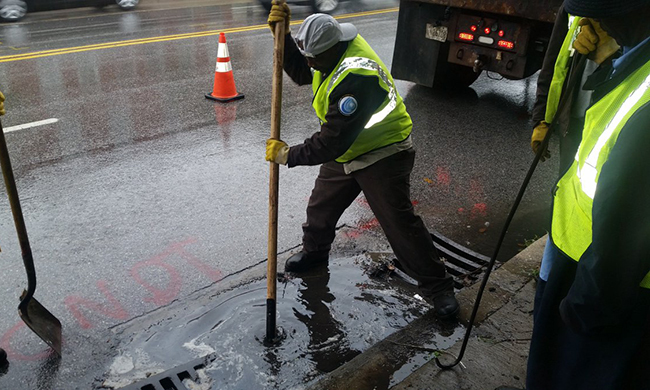
As Hurricane Dorian approaches the east coast as a Category 1 storm, its effects—and the conversation around storm preparedness—begins anew once again. While Baltimore won’t feel the impact of the hurricane in large order, it’s a good time to assess the measures the city has in place to prevent maximum damage from large storm events, especially in the wake of the recent flooding that plagued the city one month ago this week.
“Across the nation, we are experiencing more frequent and intense rainfall events,” says Marccus Hendricks, an assistant professor at the University of Maryland whose specialties include stormwater infrastructure resilience and social impact of storms. “And Baltimore has had its fair share. The potential for catastrophe is similar across them.”
It’s here that the biggest concerns are raised. There are infrastructure issues across the city that are not being addressed, and observing the impact of storms elsewhere serves as a grave reminder for what could happen here. As Hendricks notes, the eastern seaboard is not immune to potential hurricanes or tropical storm events.
“This is the new normal,” Hendricks says. “I think we’ve only seen the tip of the iceberg of how these types of storm events will be. Frequent rainfall is one of the more immediate events that we’re seeing that are linked and connected to a change in climate. The onus is on us—really yesterday—to start preparing for these types of events.”
Sandra Knight, a disaster resilience specialist who has worked with government agencies such as FEMA, says the solutions to combating these issues starts with infrastructure. “It’s about how we implement land use and building codes,” Knight says. “It’s also about preparation—we all need to be conscious of future conditions.”
Hendricks suggests that updating building codes could also be beneficial—providing specific blueprints and specifications for how construction should be carried out to shield against the effects of major storms. Part of this, too, is identifying and building away from areas that are sensitive or have proven to be more at-risk toward weather events.
“Even if we don’t experience the storm surge and the wind from a hurricane and it’s reduced to a tropical storm, it’s the stalled rainfall event that we started to see increasingly with these storms,” Hendricks says. “That’s what poses a strong threat in terms of spreading from the rainfall.”
It can be hard not to think of these types of disasters in the abstract, but that doesn’t mean the threat isn’t real. A 2014 National Oceanic and Atmospheric Administration post highlighted the findings of its report surrounding “Sea Level Rise and Nuisance Flood Frequency Changes around the United States,” noting that “nuisance flooding,” defined by the type of road closures and overcrowded storm drains, has increased on all three U.S. coasts between 300 and 925 percent since the 1960s. It’s these types of byproducts Baltimoreans are all too familiar with, and there’s data to back it up. In that same report, Annapolis and Baltimore lead the study with an increase in the number of flood days of more than 920 percent since 1960.
“The risk is there,” Hendricks says. “It may be a matter of time before we have our fair share of experience with hurricane events. We need to be investing in our current infrastructure and updating it to a level of service and a capacity that’s able to deal with some of these emerging storm events.”